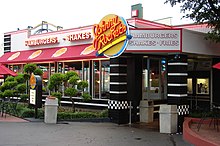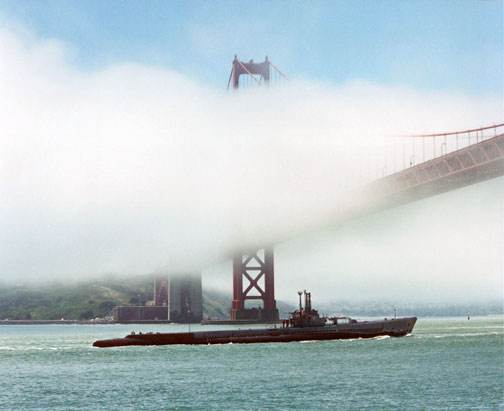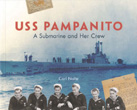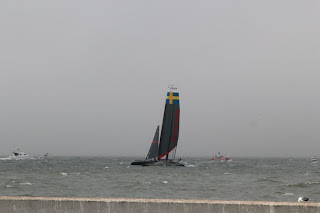Johnny Rockets
From Wikipedia, the free encyclopedia
 |
|
| Type | Private |
|---|---|
| Industry | Hamburger restaurants |
| Founded | June 6, 1986 Los Angeles, California, United States |
| Founder(s) | Ronn Teitelbaum |
| Headquarters | Aliso Viejo, California, United States |
| Number of locations | 320 (2010)[1] |
| Area served | Worldwide |
| Key people | John Fuller, CEO |
| Products | American Food Choices |
| Revenue | $300 million (2010)[2] |
| Owner(s) | RedZone Capital GP LLC |
| Website | johnnyrockets.com |
The menu, presentation, counter seating and grilling area are based on an original restaurant from 1947 (still operating today), The Apple Pan in West Los Angeles. The restaurants feature a small two-sided menu, hamburgers wrapped in paper on cardboard plates, hamburgers grilled-to-order in full view of the counter-seated customers.[3][4][5]
Contents |
History
Johnny Rockets was founded on June 6, 1986, by Ronn Teitelbaum of Los Angeles, California, and "crafted as a 'nongimmicky' recreation of the 1940s-vintage malt shops of his childhood." The first restaurant was established as a 20-stool counter operation on Melrose Avenue in Los Angeles.[4]In 1999, Royal Caribbean International featured a Johnny Rockets location onboard its Voyager of the Seas, making it the first ever "mobile" Johnny Rockets restaurant. From that point forward the cruise line has offered a Johnny Rockets location onboard all of their new cruise ships.
The world's largest Johnny Rockets franchise opened on April 25, 2006, inside the Knott's Berry Farm amusement park in Buena Park, California. The restaurant has more than 5,900 square feet (550 m2), with indoor seating for over 260 guests with an additional outdoor patio seating area. It is located in The Boardwalk section of the amusement park.[6]
In February 2007, it was announced[7] that Red Zone Capital, the private equity firm of Daniel Snyder, was set to acquire the chain. Snyder announced plans to expand the chain both within the United States and worldwide, including the launch of smaller outlets known as Johnny Rockets Express.
A sit-down restaurant owned by Six Flags (Red Zone is the largest shareholder), Trappers Adirondack Grill, was converted to a Johnny Rockets in June 2008.[8]
In April 2009, the new Yankee Stadium opened with Johnny Rockets stands throughout the site. These stands serve traditional Johnny Rockets hamburgers, french fries, shakes, and malts among other menu items. FedEx Field, home of Washington Redskins (the stadium and team are both owned by Snyder, whose company owns Johnny Rockets), features Johnny Rockets concession areas.[9]
Johnny Rockets' CEO, John Fuller, was featured on Undercover Boss on CBS.
In June 2012, American actor/ producer Don Cheadle purchased two square acres in the Uptown neighborhood of Denver Colorado which will soon be converted to the world's largest Johnny Rockets location. Cheadle, an enthusiastic and frequent patron of the chain is expected to complete renovations by December 2013.[citation needed]
An Americas Cup challenger, setting up for a race.
WELCOME TO USS PAMPANITO (SS-383)

USS Pampanito (SS-383) is a World War II Balao class Fleet submarine museum and memorial that is open for visitors daily at San Francisco's Fisherman's Wharf. Pampanito made six patrols in the Pacific during World War II during which she sank six Japanese ships and damaged four others. Operated by the Maritime Park Association, Pampanito hosts approximately 110,000 visitors a year and is one of the most popular historic vessels in the country. In addition to day time visitors, over 15,000 kids a year participate in Pampanito's educational day and overnight programs. Pampanito is a National Historic Landmark.
This photograph of Pampanito headed out under the Golden Gate Bridge was taken by volunteer Bob Taylor in 1995 when the submarine was featured in the film Down Periscope. It had been fifty years since Pampanito sailed under the bridge.
Pampanito is being restored to a specific point in time, late summer, 1945, to represent the height of WW II submarine development. The Maritime Park Association has scoured the country in search of missing equipment and spare parts. Almost all of the missing items have now been replaced and much of the equipment on board has been restored to operation.
USS Pampanito completed her fourth maintenance drydocking since becoming a museum in Jan 2007. (See the Drydocking 2007 Press Release.) We are now seeking funding and preparing for her next drydocking. We also replaced her moorings in Oct 2010.
|

On Sale: USS Pampanito -
A Submarine and Her Crew
For press/media information, please see the Press Room.

USS Makin Island (LHD-8)
From Wikipedia, the free encyclopedia
For other ships of the same name, see USS Makin Island.
 |
|
| Career | |
|---|---|
| Name: | USS Makin Island |
| Namesake: | Makin Island |
| Awarded: | 19 April 2002[1] |
| Builder: | NGSS Pascagoula[1] |
| Laid down: | 14 February 2004[1] |
| Sponsored by: | Mrs. Silke Hagee, wife of Michael Hagee |
| Christened: | 19 August 2006 |
| Launched: | 22 September 2006[1] |
| Acquired: | 16 April 2009[2] |
| Commissioned: | 24 October 2009[3] |
| Homeport: | San Diego, CA[3] |
| Motto: | Gung Ho |
| Status: | Template:Ship in active service as of 2011 |
| Badge: |  |
| General characteristics | |
| Class & type: | Wasp-class amphibious assault ship |
| Displacement: | 41,649 tons full, 28,176 tons light, 12,821 tons dead[1] |
| Length: | 847 ft (258 m) overall, 778 ft (237 m) waterline[1] |
| Beam: | 118 ft (36 m) extreme, 106 ft (32 m) waterline[1] |
| Draft: | 27 ft (8.2 m) navigational, 28 ft (8.5 m) limit[1] |
| Installed power: | 2 × 35,000 hp gas turbines (GE - LM 2500+) 6 × 4,000 kW diesel generators (Fairbanks Morse Engines) |
| Propulsion: | Integrated electric propulsion driving two shafts 70,000 shaft horsepower (52 MW) 2 × 16.5 ft diameter controllable pitch propellers (Rolls Royce) |
| Speed: | 25 kn (46 km/h) |
| Range: | 9500+ nmi. (17,600 km) at 20 knots |
| Boats & landing craft carried: |
3 × LCAC or 39 EFVs |
| Complement: | (typical) Embarked ship's company: 102 officers, 78 CPO/SNCO, 1024 crew Embarked Marine detachment: 174 officers, 64 SNCO, 1449 crew[1] |
| Armament: | 2 × Rolling Airframe Missile launchers, 2 × NATO Sea Sparrow launchers, 2 × 20 mm Phalanx CIWS mounts, 4 × 0.50 in machine guns, 3 × 25 mm Mk 38 machine guns, 1 × ceremonial gun |
| Aircraft carried: | (typical): Assault: 4[citation needed] × CH-46 helicopters, Sea Control: 6 × AV-8B attack planes, 6 × ASW helicopters |
Contents |
Construction
The purpose/mission of Makin Island is to embark, deploy, and land elements of a Marine landing force in an Amphibious Assault by helicopters, landing craft, and amphibious vehicles. The secondary/convertible mission for Makin Island is that of sea control and power projection.Although Makin Island is the eighth ship of the Wasp class, it features noteworthy technological advances. Changes from the previous LHD design include: gas turbine main propulsion engines, all-electric auxiliaries, an advanced machinery control system, water mist fire protection systems, and the Navy’s most advanced command and control and combat systems equipment. The gas turbine propulsion plant, with all electric auxiliaries, is a program first for large deck amphibious assault ships and provides significant savings in manpower and maintenance costs associated with traditional steam-powered amphibious ships. The ship carries four reverse-osmosis water-purification systems, each capable of processing 50,000 gallons of fresh water per day.[4]
History
Makin Island was laid down on 14 February 2004 by the Ingalls Shipbuilding, Pascagoula, Mississippi. She was christened on 19 August 2006, sponsored by Mrs. Silke Hagee, wife of General Michael Hagee, Commandant of the Marine Corps, and launched on 15 September 2006. In the aftermath of Hurricane Katrina, U.S. Navy officials announced that several ships under construction at Ingalls Shipbuilding had been damaged by the storm, including Makin Island and two Arleigh Burke-class destroyers. The ship's completion was delayed due to rewiring during 2008 to repair incorrect wiring installation.[4] On 21 October 2008, USS Makin Island qualified their first Surface Warfare Officer. After 15 months of training and studying, Ensign Ebony Miller, of Makin Island's deck department, became the first officer to earn a SWO pin at the command.[5]Makin Island was delivered to the U.S. Navy on 16 April 2009 and was commissioned at Pascagoula, Mississippi without ceremony on 26 June 2009 with Captain Bob Kopas in command.[3]
Makin Island departed 10 July 2009 on a transit around South America, during which the crew continued to train, obtaining underway certifications in preparation for its arrival in San Diego. During the transit, Makin Island conducted theater security cooperation (TSC) activities with Brazil, Chile and Peru, focusing on working closely with partner nation civil and maritime forces to share methods and training.[3] She arrived in her home port of San Diego on 14 September 2009. Captain Kopas stated in an interview on local radio that the Makin Island had saved about $2 million in fuel, compared with a conventional propulsion system, on her voyage from Mississippi around South America to San Diego.
Her official commissioning ceremony took place on 24 October 2009 at Naval Air Station North Island, Coronado near San Diego.[2][6] Six USMC veterans of the Makin Island raid attended the ceremony.[7]
Damage to a turning gear delayed the ship's final check-out trials from August to September 2010.[8]
Makin Island visited San Francisco in October 2010 as part of the city's 2010 Fleet Week festivities.[9]
New propulsion
Makin Island departed on its maiden deployment, as the U. S. Navy’s first hybrid-drive warship: part gas-turbine-electric and part diesel-electric.[10] About 70 percent of the time, Makin Island can use diesel-electric propulsion, saving on fuel, as diesel engines are optimized for cruising and consume much less fuel than gas turbines. When the ship needs to get from Point A to B quickly, at 12 knots or more, it uses the gas turbines.Once on station, the ship’s mission changes. Its job then is to launch Marines ashore in small boats and aircraft. While the Marines are on the ground, the ship maneuvers in a small area at slow speed, "the perfect scenario" for diesel-electric propulsion.
Fuel savings were said to be “impressive”. On an average day, the Makin Island uses 15,000 gallons of fuel, versus 35,000 to 40,000 gallons on an older steam ship of its type, said Capt. James Landers, commanding officer.
The downside is the logistical “tail,” which means it takes awhile to get parts.[citation needed] Further, the ship is software dependent, which is an independent source of failure.


This pup was/is living on a fishing boat...that's 'his' carpet on the hold acess.
It got bloody cold and damp as the fog rolled in, so finally beat feet and grabbed a trolly bus up to the Castro District.

Had a restaurant recommended to us..the Sausage Factory....and don't be in a hurry to try it. However..the brushetta appie was excellent and we wasted no time in texting Jenn in New York, teasing her.



Then...on another recommendation...and we had to head back anyway, we grabbed a bus and went up to Cortland Ave...same area we had dinner in the night before...heading to a gay woman's bar, the Wild Side, West. It has an absolutely incredible history...and a garden out back...that is worth the trio, all by itself.
This pool table..Janis Joplan used to party on....yeah...ON...


































No comments:
Post a Comment